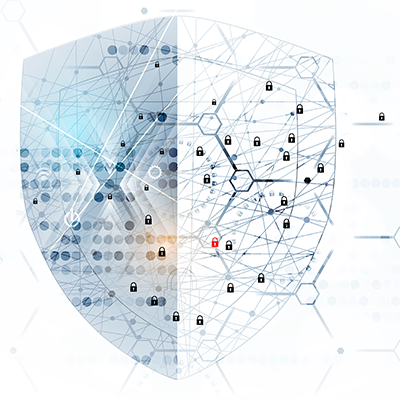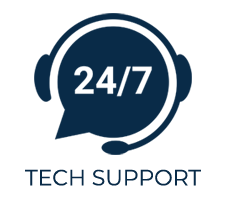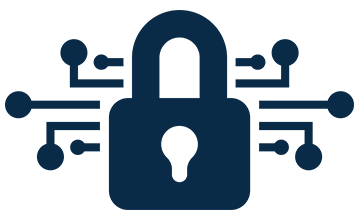
Partnering with businesses to overcome infinite challenges through technology and expertise.
 Cybertek Global offers network security services to businesses nationwide. The experienced technical team at Cybertek operates from our security operations center and provides proactive monitoring of your network and devices. Cybertek’s full suite of managed network services eliminate the cost and stress of operating systems in-house, allowing clients to focus on their businesses with the peace of mind of knowing that their technical infrastructure is continuously and proactively monitored and maintained by experienced technical professionals.
Cybertek Global offers network security services to businesses nationwide. The experienced technical team at Cybertek operates from our security operations center and provides proactive monitoring of your network and devices. Cybertek’s full suite of managed network services eliminate the cost and stress of operating systems in-house, allowing clients to focus on their businesses with the peace of mind of knowing that their technical infrastructure is continuously and proactively monitored and maintained by experienced technical professionals.
 Businesses across all industries are undergoing digital transformations in order to streamline processes, enhance efficiency, and remain competitive in the global marketplace. The integration of digital technologies such as cloud computing, data analytics, artificial intelligence, and Internet of Things (IoT) devices are commonly in place in today's business environment. Employees need to communicate 24/7 via corporate managed computing devices such as smartphones, tablets, laptops, and wearable devices. Cybertek provides monitoring and security across these platforms to ensure businesses operate smoothly.
Businesses across all industries are undergoing digital transformations in order to streamline processes, enhance efficiency, and remain competitive in the global marketplace. The integration of digital technologies such as cloud computing, data analytics, artificial intelligence, and Internet of Things (IoT) devices are commonly in place in today's business environment. Employees need to communicate 24/7 via corporate managed computing devices such as smartphones, tablets, laptops, and wearable devices. Cybertek provides monitoring and security across these platforms to ensure businesses operate smoothly.
 Cybertek has provided the highest level of enterprise level technical integrations, network security consulting and security management since 1997. Cybertek provides real-time endpoint detection and response, security monitoring, firewall management, antivirus operations, identity and access management from our security operations center located in the Louisville Metro Area.
Cybertek has provided the highest level of enterprise level technical integrations, network security consulting and security management since 1997. Cybertek provides real-time endpoint detection and response, security monitoring, firewall management, antivirus operations, identity and access management from our security operations center located in the Louisville Metro Area.
Contact Cybertek to discuss your technical challenges and to learn how our security management tools and resources, logging and monitoring program will provide you piece of mind in today's challenging business world.
The integration of technology has delivered immense benefits to business productivity, but it also presents various risks that businesses need to be aware of and take significant actions to mitigate the risk. Some serious technology risks for your businesses include:
Cyberattacks, such as malware, ransomware, phishing, and DDoS attacks, pose significant risks to businesses by compromising data confidentiality, integrity, and availability. Data breaches can result in financial losses, reputational damage, regulatory fines, and legal liabilities.
Businesses must comply with data protection regulations such as the GDPR (General Data Protection Regulation) and CCPA (California Consumer Privacy Act). Failure to protect customer data or adhere to regulatory requirements can lead to regulatory penalties, lawsuits, and damage to trust and brand reputation.
Many businesses rely on third-party vendors, suppliers, and service providers for various technology solutions and services. However, third-party relationships can introduce risks such as data breaches, service disruptions, supply chain vulnerabilities, and compliance issues. It's crucial for businesses to assess and manage the cybersecurity posture of their third-party partners.
While emerging technologies like artificial intelligence, IoT, blockchain, and cloud computing offer significant opportunities for innovation and growth, they also introduce new risks and complexities. Businesses need to carefully evaluate the security implications of adopting these technologies and implement appropriate safeguards to mitigate associated risks.
Insider threats, whether intentional or unintentional, can pose serious risks to businesses' data and systems. Employees, contractors, or partners may misuse their access privileges, mishandle sensitive information, or inadvertently cause security incidents. Implementing access controls, employee training, and monitoring mechanisms can help mitigate insider threats.
Legacy systems and outdated infrastructure may lack proper security controls and be more susceptible to vulnerabilities and cyberattacks. Businesses that rely on legacy technology face risks related to system downtime, data breaches, and compliance issues. Regularly updating and modernizing IT systems is essential for reducing these risks.
Technology failures, natural disasters, and other unforeseen events can disrupt business operations and cause data loss. Businesses need robust business continuity and disaster recovery plans in place to minimize downtime, recover critical data and systems, and maintain operations during disruptions.
Social engineering attacks, such as phishing, pretexting, and social media manipulation, exploit human psychology to trick employees into divulging sensitive information or performing unauthorized actions. Employee awareness training and security awareness programs are essential for mitigating the risk of social engineering attacks.
Businesses that rely on global supply chains face risks related to cybersecurity vulnerabilities, geopolitical factors, regulatory changes, and disruptions caused by events like natural disasters or pandemics. Conducting risk assessments, diversifying suppliers, and implementing supply chain resilience strategies can help mitigate these risks.
Inadequate information technology governance, policies, and controls can lead to mismanagement of technology resources, unauthorized access to data and systems, and compliance failures. Establishing robust IT governance frameworks, implementing security controls, and conducting regular audits are critical for reducing these risks.
By identifying, assessing, and effectively managing these technology dangers, businesses and organizations can safeguard their assets, protect their reputation, and maintain a competitive edge in today's connected digital landscape.
Recent Security Threat News Reports
Cryptocurrencies’ Central Role in Healthcare Ransomware Attacks
"Shooting in the dark:" Ascension struggles to provide some care amidst ransomware delays
Ransomware hackers raked in a record $1 billion from victims last year
Hackers Behind the Change Healthcare Ransomware Attack Just Received a $22 Million Payment
Hackers demand $700,000 ransom from Tarrant Appraisal District, attorney says
St. Cloud most recent in string of Florida cities hit with ransomware
Leader of ransomware group that attacked Jacksonvile Beach threatens more cybercrimes
Separate ransomware attacks reported by Illinois county, college
Petersen Health Care Files for Bankruptcy Following Ransomware Attacks
California city declares state of emergency after ransomware attack
Colorado public defender ransomware attack may have exposed Social Security numbers, personal data
Government facilities were third largest ransomware target in 2023, FBI says
Ransomware attack causes outages at 60 credit unions, federal agency says
'Cactus' Ransomware Strikes Schneider Electric
Cyberattack on US hospital owner diverts ambulances from emergency rooms in multiple states
An Illinois hospital is the first health care facility to link its closing to a ransomware attack
Cyberattack cost MGM Resorts about $100 million, Las Vegas company says

![]()










Cybertek employs cybersecurity professionals who are experts in their field. They stay updated with the latest threats, vulnerabilities, and security technologies. By leveraging their expertise, organizations can enhance their security posture without having to invest heavily in building an in-house security team.
Cybertek provides continuous monitoring of networks, systems, and applications for potential security threats. We offer round-the-clock threat detection and response capabilities, ensuring that security incidents are identified and addressed promptly, even outside of regular business hours.
Building an in-house security operations center (SOC) can be prohibitively expensive for many businesses. As a MSSP, Cybertek offers cost-effective security solutions, allowing your business access to advanced security technologies and expertise without the need for significant upfront investments in infrastructure, tools, and personnel.
Cybertek scales their management services according to the on-going needs of the client. An organization may be facing rapid growth or may need to downsize operations, Cybertek adjusts our services accordingly, and provides flexible solutions that will align with your business requirements.
Many industries have stringent compliance and regulatory requirements regarding data security and privacy. Cybertek can help you achieve and maintain compliance with standards such as GDPR, HIPAA, PCI DSS, and others by implementing appropriate security controls and providing documentation and reporting to demonstrate compliance.
Cybertek leverages state-of-the-art security technologies and tools to protect their clients' assets. By partnering with us, businesses gain access to advanced security solutions without the need to invest in purchasing and maintaining them in-house.
Outsourcing security management to Cybertek allows businesses and organizations to focus on their core business activities without having to worry about managing and maintaining their security infrastructure. This enables our clients to allocate resources more efficiently and concentrate on strategic initiatives that drive business growth.
In the event of a security breach or incident, Cybertek is equipped to respond quickly and effectively to mitigate the impact and minimize downtime. Our experienced incident response team can contain and remediate security incidents in a timely manner, reducing the potential damage to the your reputation and operations.
By partnering with Cybertek, you can better manage your cybersecurity risks. Cybertek conducts thorough risk assessments, identify vulnerabilities, and implement proactive security measures to mitigate risks and protect against potential threats.
Ultimately, hiring Cybertek provides you with peace of mind, knowing that your cybersecurity needs are being handled by experts who are dedicated to protecting their assets and data from cyber threats. This allows you to focus your business on your operational goals and objectives with confidence, knowing that you have a trusted partner in Cybertek managing your security operations.
 Contact Cybertek Today
Contact Cybertek TodayReady to take your business to the next level? Contact us today to schedule a meeting and discover how our security and monitoring services can propel your business forward. Don't miss out on this opportunity to revolutionize your tech landscape and ensure your piece of mind.
Let's embark on this journey together!